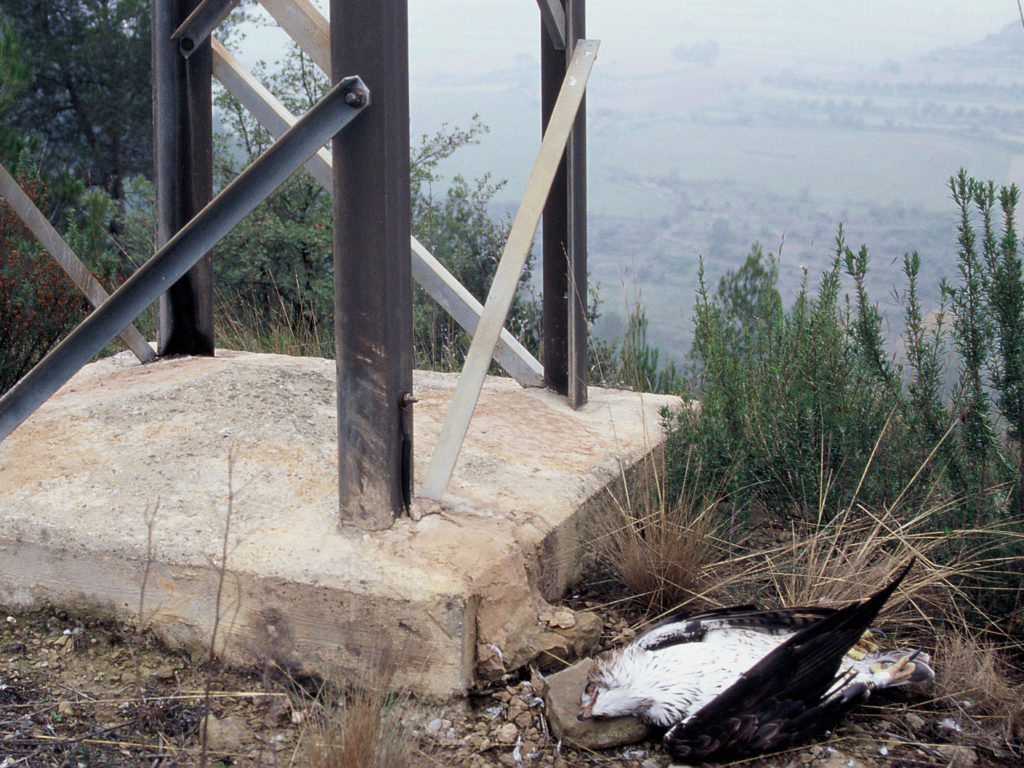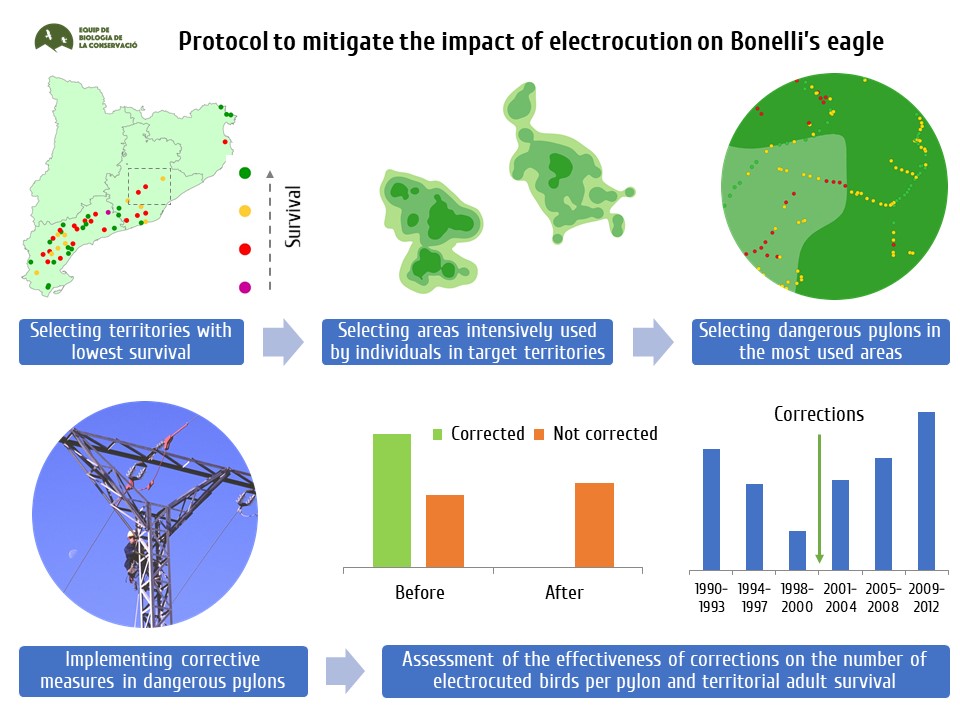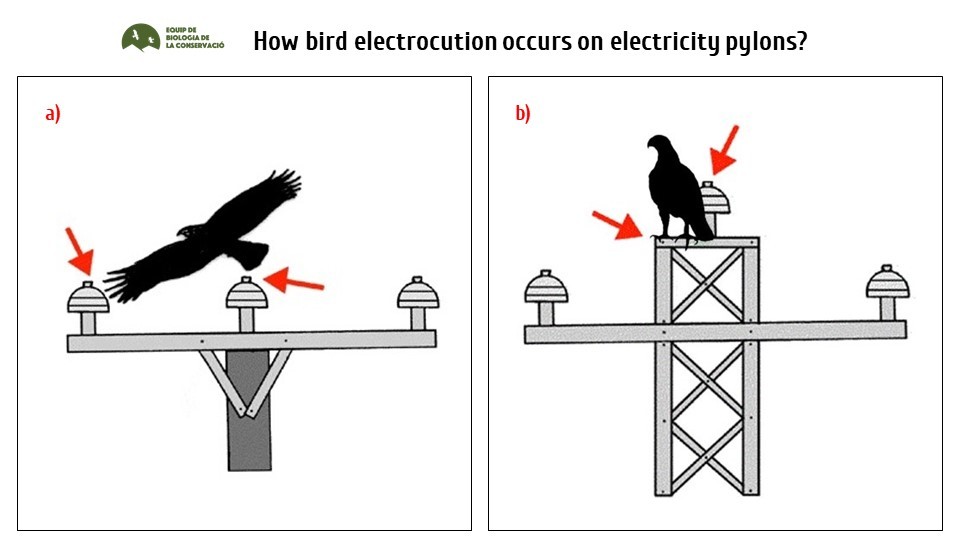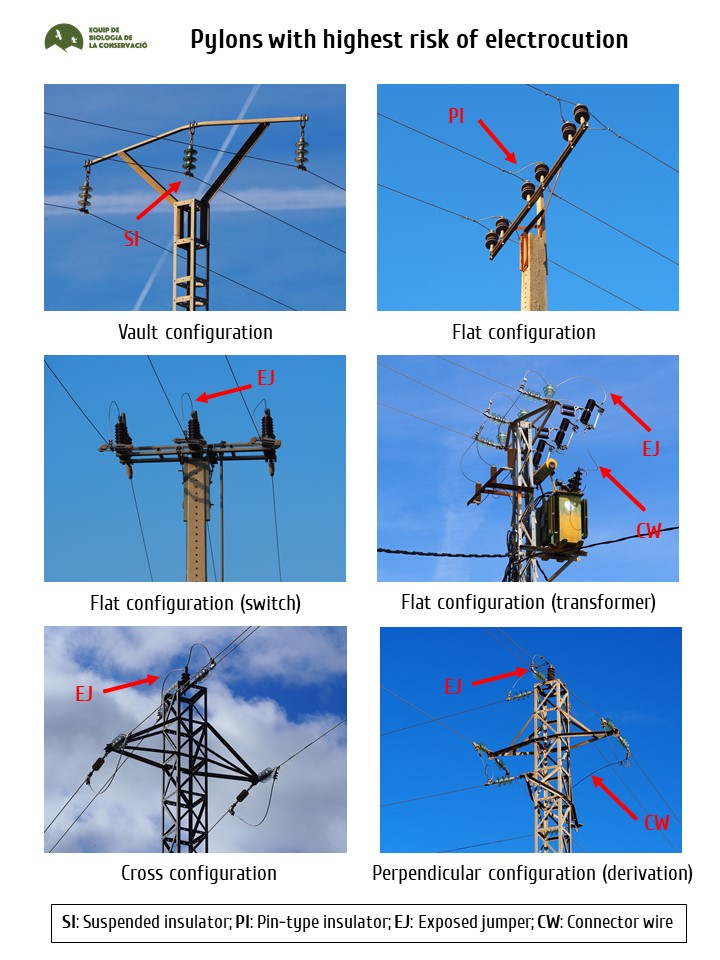Evaluation and mitigation of power lines impact on birds
Casualties with power lines, both collisions and electrocutions, are among the main causes of death for many bird species. Particularly, it has been estimated that approximately 3,000 birds per year die electrocuted on distribution power lines. Besides, it is known that electrocution is the main cause of death for the Bonelli’s eagle in Catalonia and increasing the survival of territorial individuals is the most efficient strategy to improve the conservation status of this species.
For these reasons, during the 2000-2007 and in the framework of a cooperation agreement with the company Endesa and the Diputació de Barcelona (Barcelona Provincial Council), we developed a protocol of action to mitigate the negative impact of electrocution on the Bonelli’s eagle population in Catalonia. To do so, a pilot area of 1,056 km², including 3 eagle’s territories with low survival and a high mortality rate for electrocution, was selected. Individuals from these territories were tagged (2002-2006) to determine which areas were the most intensively used by eagles. In this pilot area, we developed a predictive model to determine the risk of electrocution according to pylon design and location, thanks to the characterization of 3,869 pylons. Subsequently, this predictive model was applied to select the most dangerous pylons within the 3 focal territories. According to this model, applying correction measures to only 6% of the most dangerous pylons could reduce bird mortality by up to 70%. Then, corrective measures were implemented in most of the more dangerous pylons predicted by the model. These measures resulted completely effective to mitigate bird electrocution, since no more electrocuted birds were found under corrected pylons survival of the focal territories markedly increased after corrections.
In addition, in a later study we used data from a long-term capture–recapture programme (combining resightings of live birds and recovery of dead birds) carried out on the French population of the Bonelli’s eagle from 1990 to 2009 to estimate the impact of the insulation of power lines on key demographic rates. We found that the survival probability of all age classes increased after the insulation of dangerous power lines, due to a decrease in mortality caused by electrocution, leading to a sharp increase in predicted population growth rates, thus demonstrating the effectiveness of corrections. Then, the protocol to mitigate bird electrocution allows focusing on the most dangerous pylons, optimizing the resources devoted to correction (money and time) and resulting in very positive effects on eagles. Therefore, it is essential that this protocol is implemented in new areas to completely mitigate the negative impact of the electrocution on the Catalan population of Bonelli’s eagle.
On the other hand, collision with transmission lines is a lesser-known problem than electrocution and is harder to detect because it can occur at any point along the transmission line. To study factors involved in collisions of Bonelli’s eagles with power lines we used data on the movements of 18 territorial individuals in 12 different territories obtained by means of radio-tracking carried out during 2000-2006. This study, which was supported by Red Eléctrica de España – S.A.U., the Diputació de Barcelona and the Ministerio de Educación y Ciencia, presents a predictive model for determining which lines and spans create the greatest risk of collision, describing the most effective strategies for reducing the number of accidents caused by transmission lines.
Through its research, we have developed a strategic analytical tool that will be of use to any public or private body involved in environment management in areas where transmission infrastructures have had adverse effects on bird life – a specific environmental problem recognized by the Convention on Migratory Species (Bonn Convention, 2002) and in many EU conservation directives, as well as receiving specific mention in the recent decree on power transmission lines announced by the Spanish government.
Related publications
A53.- HERNÁNDEZ-MATÍAS, A., MAÑOSA, S., ROLLAN, À., BOSCH, R., TINTÓ, A., REAL, J. 2020. Using multi-scale spatial prioritization criteria to optimize non-natural mortality mitigation of target species. Global Ecology and Conservation, 23: e01082. https://doi.org/10.1016/j.gecco.2020.e01082 pdf
A39.- HERNÁNDEZ-MATÍAS, A., REAL, J., PARÉS, F. & PRADEL, R. 2015. Electrocution threatens the viability of populations of the endangered Bonelli’s eagle (Aquila fasciata) in Southern Europe. Biological Conservation, 191: 110-116. http://dx.doi.org/10.1016/j.biocon.2015.06.028 pdf
A38.- CHEVALLIER, C., HERNÁNDEZ-MATÍAS, A., REAL, J., VINCENT-MARTIN, N., RAVAYROL, A. & BESNARD, A. 2015. Retrofitting of power lines effectively reduces mortality by electrocution in large birds: an example with the endangered Bonelli’s eagle. Journal of Applied Ecology. doi: 10.1111/1365-2664.12476 pdf
A28.- TINTÓ, A., REAL, J. & MAÑOSA, S. 2010. Predicting and correcting electrocution of birds in mediterranean areas. The Journal of Wildlife Management, 74 (8): 1852–1862. doi: 10.2193/2009-521. pdf
A26.- ROLLAN, A., REAL, J., BOSCH, R., TINTÓ, A. & HERNÁNDEZ-MATÍAS, A. 2010. Modelling the risk of collision with power lines in Bonelli’s Eagles Aquila fasciata and its implications for conservation. Bird Conservation International, 20: 279-294. doi:10.1017/S0959270910000250. pdf
A17.- MAÑOSA, S. & REAL, J. 2001. Potential negative effects of collision with transmission lines on a Bonelli’s eagle population. Journal of Raptor Research, 35 (3): 247-252. pdf
B25.- REAL, J., HERNÁNDEZ-MATÍAS, A., ROLLAN, À. & TINTÓ, A. 2015. El águila perdicera en Cataluña: de la amenaza a la conservación. Aplicaciones a la mitigación de la electrocución. Universitat de Barcelona – Endesa, S.A. pdf
E30.- TINTÓ, A., REAL, J. & MAÑOSA, S. 2009. Modeling the Electrocution Risk of Raptors in Powerlines and Evaluating Mortality Rates at Corrected Pylons. In: Raptor Research Foundation. 2009 Annual Conference. 29 September – 4 October 2009. Pitlochry, Scotland. pdf
E25.- TINTÓ, A. & REAL, J. 2008. Aplicació de mesures per evitar l’electrocució d’aus al Parc Natural del Montseny i àrees circumdants. VII Trobada d’estudiosos del Montseny. Granollers (Barcelona). pdf
E20.- TINTÓ, A., REAL, J. & MAÑOSA, S. 2005. A classification method of power lines to prevent forest fires caused by bird electrocution. II International Conference on prevention strategies of fires of Southern Europe. Barcelona. pdf
E15.- TINTÓ, A. & REAL, J. Aplicación de medidas para mitigar la electrocución del águila perdicera en Cataluña. Jornadas nacionales de líneas elèctricas y conservación de aves en espacios naturales protegidos. Sierra de Espuña, Múrcia (Espanya). 2003. pdf
E14.- TINTÓ, A., REAL, J. & MAÑOSA, S. 2001. Avaluació del risc d’electrocució d’aus en línies elèctriques situades al Parc Natural de Sant Llorenç del Munt i l’Obac i rodalies. V Trobada d’estudiosos de Sant Llorenç del Munt i l’Obac. Castellar del Vallès (Barcelona). pdf




